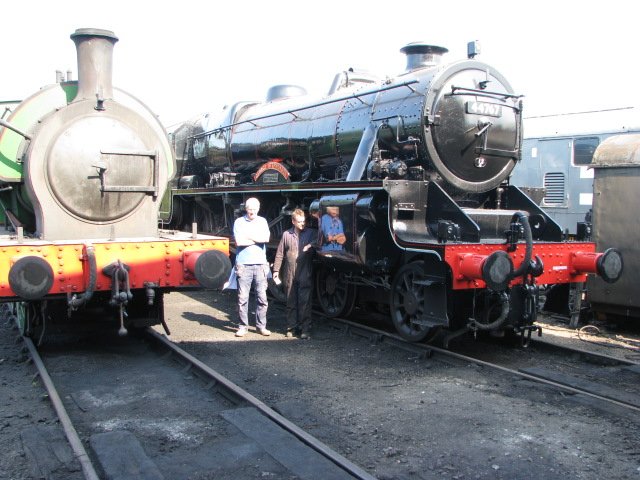World War II Days are very popular on steam preservation railways. Visitors and volunteers don period costume to recreate this most memorable period in British history. These events even include “German invaders” who capture a train station that has to be recaptured.
As I walked down the end of the station platform, Andy and Bob were having their tea break. As I began talking to them, #5619 was pulling into the station - not with a passenger train, because that was on my platform - but with 4-6-2 steam locomotive Battle of Britain 92 Squadron #34081. The loco was in the process of being shipped permanently off the NNR down south. The station switcher, diesel #D2063, with passenger coach attached, coupled up to the 4-6-2 and pulled it up and onto a siding where it was going to be loaded onto a lorry (tractor-trailer float). While at the NNR, the 4-6-2 developed major problems requiring a major overhaul. The owning group couldn’t raise the funds for the overhaul so arrangements were being made to send it to another steam preservation railway down south.
While I was photographing these movements, the general and the matron, along with an air raid warden, trooped by with a class of school children. The kids were dressed in period costumes - at least to the extent that they could find old clothes. In preparation for this trip, they had prepared large name tags with their names on them, and cardboard boxes marked “gas mask”. Instructions were given by the matron and the general as to the do’s-and-don’ts when on the railway and if the train should be attacked, much the same as during those days of WWII. .
They would be travelling up to the end of the line at Holt to the NNR's Education Centre for a day of instruction and replication of what their grandparents went through during the days of WWII. In addition to the history lesson, they would learn how to don their gas masks, the importance of air raid warnings, and how to scramble into the air raid shelters. And they would have the joy of eating spam for breakfast, lunch, and dinner (no peanut butter and jam back in those days!) (okay, so the kids would only be eating spam for lunch as they would be back home in time for dinner).
These are regular events on the NNR as teaching the history of WWII is part of the British school curriculum. The NNR fits quite nicely into this part of their history.
Before the 4-6-2 came down from Weybourne sheds, the lorry had delivered Black Five 4-6-0 #44767 with her tender still to be unloaded and put on the tracks. Steam locos are readily loaded onto lorries and trucked all over the country from steam preservation railway to steam preservation railway.
I arrived at Weybourne at my usual 10:45 to meet new volunteers, Malcolm and Sylvia, along with Mike who I had met the week before. Each person was working away on their assigned tasks, the sum of which would result in the ultimate restoration of a piece of historic rolling stock. This was a case where Mike wire brushing the rust off of some steel brackets, Sylvia brushing on some rust remover to the steel brackets, Malcolm painting some 1/4” plywood for a coach, and me working away sanding, counter-sinking, drilling, priming and painting a strip of wood 2”x 1/4”x 6’would result in the overall restoration of a coach or coaches.
I had the piece of teak wood trim sanded, countersunk, drilled, and the first coat of primer put on by 13:00, at which time, it was time for lunch.
Black Five 4-6-0 #44767 arrived at Weybourne in time for tea at 3 pm hauled by the Class 37 diesel, so this required a close look-see by all concerned. Here’s Mike and André reluctantly posing for their photo.
Back to Sheringham by 5:30 in time to get a bit of laundry done and to write up the blog before hitting the hay.







1 comment:
Thanks for the info about how the NNR is relevant to today's schoolchildren. It helps me understand why there's so much effort spent on the line, and why there are staff and so many volunteers.
Post a Comment